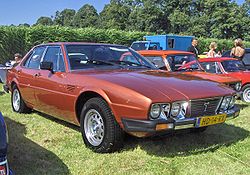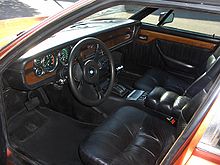De Tomaso Deauville
| De Tomaso | |
|---|---|
|
De Tomaso Deauville (1978–1988)
|
|
| Deauville | |
| Production period: | 1971-1988 |
| Class : | Upper class |
| Body versions : | limousine |
| Engines: |
Otto engine : 5.8 liters (243 kW) |
| Length: | 4851 mm |
| Width: | 1880 mm |
| Height: | 1372 mm |
| Wheelbase : | 2770 mm |
| Empty weight : | 1940 kg |
The De Tomaso Deauville is a four-door sedan produced by the Italian car manufacturer De Tomaso from Modena .
The name of the vehicle indicates the French seaside resort of Deauville , which is home to a well-known horse racing track. Brand founder Alejandro De Tomaso took into account the preference of his wife Isabell Haskell for horse racing.
concept
Conceptually, the Deauville was intended as a competitor to the Jaguar XJ6 , which appeared in late summer 1968 . At the same time it was supposed to fill the gap in the national market that the Maserati Quattroporte I, which was discontinued at the end of 1970, was to leave behind.
Originator
On the occasion of the presentation of the Deauville, Alejandro de Tomaso claimed that the body design could be traced back to his friend, Milanese fashion designer Giulia Moselli . In fact, Tom Tjaarda , who was the head of design at Carrozzeria Ghia at the time , designed the car.
A Jaguar copy?
While the Deauville design is seen as a mere copy of the Jaguar XJ6 in numerous descriptions, Tjaarda stated in an interview from 2011 that he had developed the design of the Deauville before the Jaguar sedan was presented: the design was ready before Alejandro De Tomaso decided to build a four-door sedan. According to Tjaarda, the design goes back to a Ghia study that he developed on behalf of the American Ford group. Its president at the time, Lee Iacocca, was interested in a European-style, compact sports sedan according to American standards. When designing the Deauville body, Tjaarda cited the lines of the Lancia Marica and the De Tomaso Mustela I , two studies he had previously designed for Ghia. Four years later, however, he stated in another interview that he had been commissioned to design a car that "looks like the Jaguar XJ, but is not a Jaguar."
In any case, the design of the Deauville shares some conceptual similarities with that of the Jaguar XJ. Some detailed questions were resolved identically, such as the bonnet, which opened together with the radiator grille, inner headlights and front bumper, and the two separately accessible tanks.
technology
The chassis and floor pan of the Deauville were designed by Giampaolo Dallara ; Carrozzeria Vignale dealt with the details of the construction .
The car is equipped all around with individually suspended wheels on double wishbones . The engine is as simple as it is powerful and solid: As in the Pantera, De Tomaso used an eight-cylinder from the Ford Cleveland series. Officially, its output was throttled to 270 hp, but in fact only particularly powerful engines were used to give the almost two-ton sedan sporty performance. The gearbox is a Ford C6 automatic. De Tomaso also used numerous add-on parts from mass production: the rear axle was taken over from the Jaguar Mark X , and the steering column came from Lincoln production.
Model history
Series 1 (1971–1978)
The De Tomaso Deauville was presented at the Turin Motor Show in 1970. Production remained low. The plant reached its highest annual output in 1972 when 46 Deauvilles were produced.
Series 2 (1978–1988)
In 1978 a second series of the Deauville was presented. It was characterized by a modified chassis geometry and a different positioning of the engine. The engine was now moved ten centimeters further back with a view to better weight distribution. Finally, the previous Lincoln steering was replaced by a design from ZF .
Visually, the Deauvilles of the second series initially corresponded to those of the series 1. It was not until 1980 that they were given wider bumpers encased in rubber, in which the front indicators were integrated, analogous to the De Tomaso Longchamp .
The revised chassis of the Deauville were used from 1978 as the basis for the new Maserati Quattroporte III , which was much more successful than the Deauville.
Special versions
- The Carrozzeria Pavesi manufactured several armored versions of the Deauville. One of these vehicles was used as an official vehicle by the then Italian President Sandro Pertini .
- A five-door station wagon was derived from the Deauville of the second series in 1984. The design of the front section had been revised in detail; it resembled the design of the Maserati Biturbo with four rectangular headlights . Embo SpA manufactured the vehicle on behalf of De Tomaso. The estate was unique and was reserved for use by the de Tomaso family.
Success and Importance of Deauville
The De Tomaso Deauville was not a commercial success. Production of the sedan ended in 1986, but the last vehicles were sold until 1988. During this time 355 copies were made. More than 46 vehicles per year (1972) were never produced.
The Deauville is described in most publications as a high-quality vehicle that was clearly superior to the Iso Fidia in terms of workmanship, sportiness and comfort and in some areas came close to the qualities of the Jaguar XJ. The lack of success of the car is mostly attributed to its closeness to American large-scale production, which is evident in many details, due to which it lagged behind the image of a Maserati Quattroporte or that of the Jaguar XJ.
In addition, the Deauville was a very expensive car. In the early 1970s, it cost four times as much as a Jaguar XJ6 on the British market, and in 1978 it was only slightly cheaper than a Mercedes-Benz 450 SEL 6.9 in Germany . With the introduction of this exclusive Mercedes model, but above all with the presentation of the twelve-cylinder Jaguar XJ12, the Deauville lost its status as the fastest production sedan in Europe. Both models - the Jaguar and the Mercedes - were faster, more suitable for everyday use and less expensive to maintain than the Deauville.
Competitors
- Aston Martin Lagonda Series 1
- Bentley T-Series
- BMW 2500/2580
- Citroën SM Opéra
- Iso Fidia
- Jaguar Mark X
- Daimler Double Six
- Maserati Quattroporte II
- Mercedes-Benz 450 SEL 6.9
- Monica 560
- Monteverdi High-Speed 375/4
- Rolls-Royce Silver Shadow
literature
- Georg Amtmann, Halwart Schrader: Italian sports cars. (From Abarth and Alfa Romeo to Vignale and Zagato. Brands, history, technology, data). Motorbuch-Verlag, Stuttgart 1999, ISBN 3-613-01988-4 .
- Sam Dawson: The Age of Understatement . Design and model history of Deauville in: Thoroughbred & Classic Cars, issue 2/2012, p. 90 ff.
- Major Tom . Driving report De Tomaso Deauville with development history in: Motor Klassik, issue 6/2001, p. 54 ff.
- Five smokin 'saloons : Presentation of the Aston Martin Lagonda (Series 1) and comparison with the BMW 3.0 Si, the Daimler Doulbe Six Vanden Plas, the De Tomaso Deauville and the Mercedes-Benz 300 SEL 6.3, in: Thoroughbred and Classic Cars, February 1996, pp. 76 ff. (Eng.).
- Money no object : Aston Martin Lagonda vs. Bitter CD vs. De Tomaso Deauville vs. Iso Fidia vs. Maserati Quattroporte. Comparative test of Italian four-door cars in Thoroughbred & Classic Cars issue 9/2008, p. 60 ff.
Individual evidence
- ↑ In enthusiasts' circles, the car is feminine ; see. Motor Klassik 6/2001, p. 55
- ↑ The naming of De Tomaso Longchamp , introduced a little later, also followed this pattern.
- ↑ See Motor Klassik 6/2001, p. 54 ff.
- ↑ a b Manuel Bordini: De Tomaso visto da vicino: intervista a Tom Tjaarda. www.vitadistile.com, November 10, 2015, accessed February 8, 2017 .
- ↑ Overview of Tjaarda's designs on www.tom-tjaarda.net
- ↑ Thoroughbred & Classic Cars 2/1996, p. 76 ff
- ^ Georg Amtmann, Halwart Schrader: Italian sports cars. (From Abarth and Alfa Romeo to Vignale and Zagato. Brands, history, technology, data). Motorbuch-Verlag, Stuttgart 1999, ISBN 3-613-01988-4 ; Brazendale, p. 126; Lillywhite / Schrader p. 148
- ^ Illustration of the Lancia Marica
- ↑ Illustration of De Tomaso Mustela I
- ↑ On the design history of Deauville cf. Thoroughbred & Classic Cars, issue 2/2012, pp. 90, 92.
- ↑ On the design history of Deauville cf. Thoroughbred & Classic Cars, issue 2/2012, pp. 90, 92.
- ↑ Thoroughbred & Classic Cars 2/1996, p. 76 ff
- ↑ Motor Klassik 6/2001, p. 56
- ↑ Several images on the Embo website.
- ↑ Illustration of the De Tomaso Deauville Estate
- ↑ Schrader / Amtmann, p. 106
- ^ Georg Amtmann, Halwart Schrader: Italian sports cars. (From Abarth and Alfa Romeo to Vignale and Zagato. Brands, history, technology, data). Motorbuch-Verlag, Stuttgart 1999, ISBN 3-613-01988-4 ; Brazendale, p. 126; Lillywhite / Schrader p. 148
- ↑ Motor Klassik 6/2001, p. 54 ff.
- ↑ Lillywhite / Schrader, p. 148
- ↑ For an analysis of market success, cf. Thoroughbred & Classic Cars, issue 2/2012, p. 90, p: 94.


